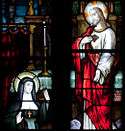Popular piety
Popular piety, as defined in the Directory on Popular Piety and the Liturgy issued by the Congregation for Divine Worship and the Discipline of the Sacraments in 2001, means the various forms of prayer and worship that Christians practice either singly or in community and that are inspired by their culture rather than by the liturgy.[1]
Value
The Catholic Church has declared popular piety "a true treasure of the People of God"[2] and decried the attitude of "certain persons concerned with the care of souls who scorn, a priori, devotions of piety which, in their correct forms, have been recommended by the magisterium, who leave them aside and in this way create a vacuum which they do not fill."[3]
Relation to the liturgy
The Second Vatican Council asked that popular Catholic devotions "should be so drawn up that they harmonize with the liturgical seasons, accord with the sacred liturgy, are in some fashion derived from it, and lead the people to it, since, in fact, the liturgy by its very nature far surpasses any of them."[4]
During the Middle Ages the public functions of the Church and the popular devotions of the people were intimately connected. The laity assisted at the daily Liturgy of the Hours psalmody, the sacrifice of the Mass, the numerous processions, and were quite familiar with the liturgy. Those few religious practices outside of official services, e.g. the Rosary (a substitute for the 150 Psalms) originated in the liturgy.[5]
At the beginning of the modern period, "the primacy accorded to contemplation, the importance attributed to subjectivity and a certain ascetical pragmatism exalting human endeavour ensured that Liturgy no longer appeared as the primary source of the Christian life in the eyes of men and women advanced in the spiritual life."[6] The reform of the Roman liturgy after the Council of Trent brought advantages such as ensuring that the doctrinal content reflected the faith in its purity, but its new fixity made it seem the reserve of the clergy and reinforced a division between liturgy and popular piety.[7]
Popular devotion then followed its own channels, especially since the 16th century. Non-liturgical practices like the Stations of the Cross, the Forty Hours' Devotion, various litanies and rosary-based prayers and chaplets prevailed everywhere; novenas and series of Sundays and weekdays in honour of particular saints or mysteries were instituted.[5]
Entire months of the year were given over to special devotions, the most widespread being: January (Holy Name of Jesus); March (Saint Joseph); May (Virgin Mary); June (Sacred Heart); July (Precious Blood); September (Our Lady of Sorrows); October (Rosary); November (Souls in Purgatory).[5]
A renaissance of liturgical worship began in the late 19th century and was advanced by the reforms of Pope Pius X and his 20th-century successors.[8]
Practices of popular piety
The Directory on Popular Piety and the Liturgy devotes separate chapters to consideration of practices associated with the liturgical year, veneration of the Mother of God, veneration of the other saints and the beatified, praying for the dead, and shrines and pilgrimages.
Under the heading "The language of popular piety", it speaks of gestures, texts and formulae, song and music, sacred music, sacred places and sacred times.
For an overview of some practices that form part of Catholic popular piety, see Catholic devotions.
Regulation
The Directory declares: "Manifestations of popular piety are subject to the jurisdiction of the local Ordinary. It is for him to regulate such manifestations, to encourage them as a means of assisting the faithful in living the Christian life, and to purify and evangelize them where necessary."
In application of this principle, members of the Church, clergy or laity, individuals or groups, must obtain the local ordinary's permission to promote prayers, formulas or private initiatives in this field.
On a level beyond the confines of single dioceses, competence belongs to the Congregation for Divine Worship and the Discipline of the Sacraments.[9]
See also
Notes
- ↑ Directory on Popular Piety and the Liturgy, 9
- ↑ Pope John Paul II, Homily at La Serena, Chile, 5 April 1987
- ↑ Pope Paul VI, Apostolic Exhortation Marialis cultus, 31
- ↑ Second Vatican Council, Constitution on the Sacred Liturgy Sacrosanctum Concilium, 13
- 1 2 3
 Herbermann, Charles, ed. (1913). "Special Devotions for Months". Catholic Encyclopedia. New York: Robert Appleton Company.
Herbermann, Charles, ed. (1913). "Special Devotions for Months". Catholic Encyclopedia. New York: Robert Appleton Company. - ↑ Directory on Popular Piety and the Liturgy, 34]
- ↑ Directory on Popular Piety and the Liturgy, 40
- ↑ Directory on Popular Piety and the Liturgy, 44-46
- ↑ Directory on Popular Piety and the Liturgy, 21
